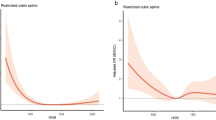Abstract
There are few previous studies on the relationship between cerebral infarction and acute anemia. This study presents patients with cerebral infarction in acute anemia due to marked blood loss and aims to clarify the stroke nature and possible mechanism. Patients with acute cerebral infarction and anemia following marked blood loss without systemic hypotension were recruited from 2001 to 2009. Clinical characteristics, particularly hemoglobin level, and neuroimaging findings were reviewed in detail to analyze the stroke nature and verify the possible pathogenesis. Twelve patients (males 8; mean age 74.9 years) were included. Eleven patients had cerebral infarction after acute massive gastrointestinal bleeding, and one had cerebral infarction following postoperative extensive hematoma during hospitalization. In all patients, borderzone infarction was the most characteristic finding: six had unilateral and six had bilateral borderzone infarction. Mean hemoglobin at infarction after acute blood loss was 5.8 g/dl, with 46% reduction from baseline. Of nine patients receiving detailed extracranial and intracranial vascular studies, none had severe carotid stenosis and six had intracranial stenosis. The arterial borderzones are the most vulnerable regions to a fall in cerebral perfusion. Acute anemia may produce cerebral blood flow insufficiency, reduce oxygen-carrying capacity, and result in distal-field tissue ischemic injury when hemoglobin level decreases below a critical level, especially in patients with intracranial stenosis.

Similar content being viewed by others
References
Sacco RL, Benjamin EJ, Broderick JP et al (1997) Risk factors panel—American Heart Association Prevention Conference IV. Stroke 28:1507–1517
Wilterdink JL, Easton JD (1992) Vascular event rates in patients with atherosclerotic cerebrovascular disease. Arch Neurol 49:857–863
Hannah R, Goldberg A (1996) Cerebral infarction following gastrointestinal hemorrhage. Scott Med J 11:153–158
Bosel J, Rsucher K, Ploner CJ et al (2005) Delayed neurological deterioration in a stroke patient with postoperative acute anemia. Eur Neurol 53:36–38
Damasio H (1983) A computed tomographic guide to identification of cerebral vascular territories. Arch Neurol 40:138–142
Ringelstein EB, Stogbauer F (2001) Border zone infarcts. In: Bogousslavsky J, Caplan L (eds) Stroke syndromes. Cambridge University Press, London, pp 564–582
Torvik A (1984) The pathogenesis of watershed infarcts in the brain. Stroke 15:221–223
Adams JH, Brierley JB, Connor RCR et al (1966) The effects of systemic hypotension upon the human brain. Brain 89:235–268
Ross RW, Bharucha N (1978) Recognition and prevention of borderzone cerebral ischemia during cardiac surgery. Q J Med 47:303–323
Bogousslavsky J, Regli F (1986) Borderzone infarctions distal to internal carotid artery occlusion: prognostic implications. Ann Neurol 20:346–350
Wodarz R (1980) Watershed infarctions and computed tomography. A topographical study in cases with stenosis or occlusion of the carotid artery. Neuroradiology 19:245–248
Ringelstein EB, Zeumer H, Angelou D (1983) The pathogenesis of stroke from internal carotid artery occlusion. Diagnostic and therapeutic implications. Stroke 14:867–875
Leblanc R, Yamamoto L, Tyler JL et al (1987) Borderzone ischemia. Ann Neurol 22:707–713
Nornes H (1973) The role of the circle of Willis in graded occlusion of the internal carotid artery in man. Acta Neurochir 28:165–177
Liu HM, Tu YK, Yip PK, Su CT (1996) Evaluation of intracranial, extracranial carotid steno-occlusive diseases in Taiwan Chinese patients with MR angiography: preliminary experience. Stroke 27(4):650–653
Wang KS, Huang YN, Gao S et al (1998) Intracranial stenosis in Chinese with acute stroke. Neurology 50:812–813
Shahar A, Sadeh M (1991) Severe anemia associated with transient neurological deficits. Stroke 22:1201–1202
Young RSK, Rannels DE, Hilmo A et al (1983) Severe anemia in childhood presenting as transient ischemic attacks. Stroke 14:622–623
Bruggers CS, Ware R, Altman AJ et al (1990) Reversible focal neurologic deficits in severe iron deficiency anemia. J Pediatr 117:430–432
Kim JS, Kang SY (2000) Bleeding and subsequent anemia: a precipitant for cerebral infarction. Eur Neurol 43:201–208
Baron JC (2000) Perfusion thresholds in human cerebral ischemia: historical perspective and therapeutic implications. Cerebrovasc Dis 11(suppl 1):2–8
Yamauchi H, Nishii R, Higashi T, Kagawa S, Fukuyama H (2009) Hemodynamic compromise as a cause of internal borderzone infarction and cortical neuron damage in atherosclerotic middle cerebral artery disease. Stroke 40:3730–3735
Yamauchi H, Fukuyama H, Nagahama Y, Katsumi Y, Hayashi T, Okazawa H, Yonekura Y (1999) Selective cerebral hematocrit decrease in the centrum semiovale after carotid artery occlusion: a PET study. J Cereb Blood Flow Metab 19:109–114
Yamauchi H, Fukuyama H, Nagahama Y, Shiozaki T, Nishizawa S, Konishi J, Shio H, Kimura J (1999) Brain arteriolosclerosis and hemodynamic disturbance may induce leukoaraiosis. Neurology 53:1833–1838
Dexter F, Hindman BJ (1997) Effect of hemoglobin concentration on brain oxygenation in focal stroke: a mathematical modeling study. Br J Anaesth 79:346–351
Kumral E, Bayulkem G, Sagcan A (2004) Mechanisms of single and multiple borderzone infarct: transcranial Doppler ultrasound/magnetic resonance imaging correlates. Cerebrovasc Dis 17:287–295
Akins PT, Glenn S, Nemeth PM et al (1996) Carotid artery thrombosis associated with severe iron deficiency anemia and thrombocytosis. Stroke 27:1002–1005
Jones TH, Morawetz RB, Crowell RM et al (1981) Thresholds of focal cerebral ischemia in awake monkeys. J Neurosurg 54:773–782
Fisher M, McQuillen JB (1981) Bilateral cortical borderzone infarction: a pseudobrainstem stroke. Arch Neurol 38:62–63
Conflict of interest statement
There is no potential conflict of interest.
Author information
Authors and Affiliations
Corresponding author
Rights and permissions
About this article
Cite this article
Tsai, CF., Yip, PK., Chen, CC. et al. Cerebral infarction in acute anemia. J Neurol 257, 2044–2051 (2010). https://doi.org/10.1007/s00415-010-5657-6
Received:
Revised:
Accepted:
Published:
Issue Date:
DOI: https://doi.org/10.1007/s00415-010-5657-6




